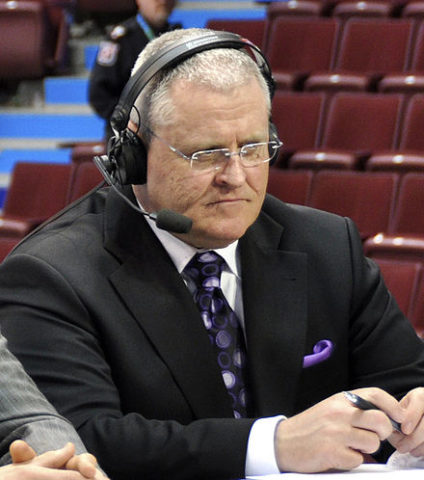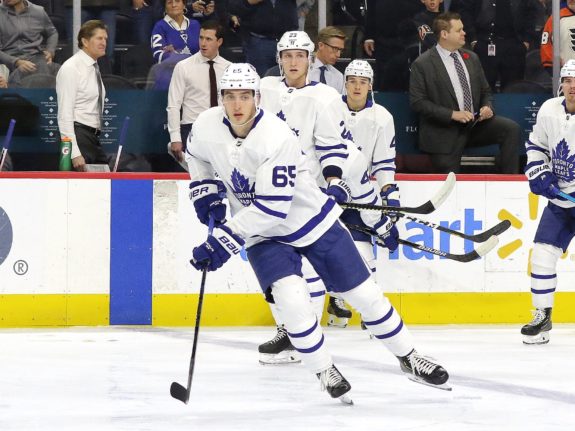As part of my research for this post on the Toronto Maple Leafs, I read Bob McKenzie’s tweets over the past 24 hours. This guy is busy.
Related: Maple Leafs News & Rumors: Brazeau, Nesterov & Mogilny
I’m continually surprised by how much hockey “insiders” know about what’s going on around the NHL, but when I see McKenzie playing golf with Maple Leafs general manager Kyle Dubas and TSN’s James Duthie in a mini-tournament for charity, it makes more sense.
In today’s post, I’ll look at four issues with the CBA that owners and players are discussing. I’ll also look at the concept of signing NHL veterans like Jason Spezza who are at the end of their careers, and suggest why Ilya Mikheyev should be one of the RFAs the Maple Leafs sign quickly this offseason.
Item One: 4 CBA Issues Being Discussed
McKenzie tweeted virtual wave after wave of information yesterday. Here I’ll share four tweets that seem especially relevant.
Issue One: Extending the CBA
McKenzie tweeted that: “On CBA extension, worth noting, the existing deal has two seasons remaining: 2020-21 and 2021-22. Will the extension be for additional 3 years? Or 4 years? Or is it 3 plus a mutual opt-out/opt-in for the 4th? CBA extension is essential for both sides to chart economic future(s).”

Comment: When the players opted not to revisit the CBA and allowed it to continue for two more seasons, that decreased their leverage for discussion. Now that COVID-19 has radically impacted the financial landscape, players are in a pickle. The issue is that most NHL players have short careers where a season might represent 10% (or more) of their total lifetime hockey income. Thus, getting paid now is a priority.
Although escrow payments are an issue, given their short careers, as much as players hate it, capitulating to it seems like a small sacrifice, which also means that the current CBA will likely be extended.
Issue Two: Capping the Escrow at 20%
McKenzie tweeted, “Also previously reported, escrow would potentially be capped at 20 percent in each of the next two seasons (20-21, 21-22) and then the complicated formula for figuring out how owners/players share burden of lost Hockey Related Revenue and over how many years.”
Related: Maple Leafs Banter with Forbes & Baracchini: Targeting Alex Pietrangelo
Comment: According to McKenzie, there’s a proposal to cap players’ escrow payments at 20 percent for the 2020-21 and the 2021-22 seasons and to figure out later a formula for how owners and players will share the loss of hockey revenue from this season and probably next. That’s assuming 2021-22 is back to normal. Hockey-related revenue loss is going to be an issue for many years to come, but a proposal would limit the escrow loss to players over the next couple of years.
Issue Three: Extending the Salary Cap at $81.5 Million
McKenzie also tweeted, “As has been widely reported, current salary cap of $81.5M likely to remain “flat” for each of next two seasons (20-21 and 21-22). Marginal bumps up possible for each of ensuing 3 or 4 seasons depending on revenues, but it could be awhile before real ‘linkage’ returns.”
Comment: Unlinking the salary cap from hockey revenue, at least for the next two seasons, seems reasonable. This means players will make 80% of their contracts, given the proposed limitation of escrow to 20% of salary. With the amount of lost hockey revenue and the length of time it will take non-radical changes to allow revenues to catch up, I believe it might take years before an accurate linkage between salary cap and hockey revenues are made.
The impact on free agents might be immense. If you are fortunate – like Mitch Marner – you’re signed long term. However, as I’ve mentioned before, it’s a poor time to be a free agent. There will be little negotiation leverage and players will likely sign shorter-term contracts as they seek employment at lower than anticipated salaries.

Will there be compliance buyouts? Will the revenue situation stop players from being traded? What will a “good” contract look like? Taylor Hall’s next contract might become an interesting case in point.
Issue Four: Deciding About Signing Bonuses
Finally, McKenzie tweeted:
Comment: I don’t think signing bonuses will be a big issue this season, I believe they will be paid, but there’s a discussion about limiting the amount of money paid out per team. That interesting conversation might impact the Maple Leafs more than any other team because Dubas tends to give out large signing bonuses because it attracts players.
There’s a lot on the table for owners and players to discuss. I anticipate hearing about hub cities today or tomorrow, but these other discussions might take some time.
Item Two: Does Jason Spezza Represent a Maple Leafs Strategy?
During the 2018-19 season, Patrick Marleau was on the Maple Leafs roster. Although he scored 16 goals and 21 assists in 82 games, he was viewed as a liability. The problem was his $6.25 million cap hit.
This season, the team had veteran Jason Spezza on the roster. He scored nine goals and 16 assists in 58 games in a limited role of just over 10 minutes of ice time per game. Those numbers seem depressed because when Mike Babcock was coach, Spezza was often a healthy scratch.

Bringing Spezza back seems like a no-brainer. Unlike Marleau, his cap hit is the league-minimum of $700,000. He was a good bang for the buck, both in scoring and leadership which suggests that Dubas has designed one prong of a strategy for easing his team’s salary cap needs. A second prong would be using young players or European transfers on inexpensive contracts.
Two things drew Spezza to Toronto. First, it’s his home. Second, he believed the team had a good chance to compete for a Stanley Cup which he has yet to achieve in his career. He’ll probably re-sign with the team for the same reason and probably won’t seek a raise to do it.
Related: NHL Players Are Planning for a Lockout
Spezza’s a veteran with experience and skill. He’s strong offensively, and 10 minutes per game seems about right given his age. He’s huge on the fourth line, the power play, or taking a key faceoff (he won 54.02% of them).
But he also represents a strategy for cost-control which Dubas can leverage because he’s in the Toronto market. Playing with the Maple Leafs is likely one of the best jobs in hockey and, even after Spezza no longer graces the roster (and I chose that verb because Spezza plays with grace), other veterans are likely to sign with the team for a similar gig. That’s a huge advantage for the Maple Leafs and a tactic the team will likely employ for many seasons.
Item Three: Signing Ilya Mikheyev Is a Priority
In addition to signing Spezza, signing Ilya Mikheyev should be a priority. Whereas Spezza’s a character player, Mikheyev’s a character. He generates enthusiasm and the fans love him. He’s an interesting young guy with skill. There’s something about him, and I hope he becomes a career Maple Leaf.

Given the cap situation, I’m unsure that management can lock up Mikheyev with a long-term contract but, if they can, they should. He must appreciate how the team has treated him, and it seems he and Dubas have been bonding, but who knows how that will translate to a contract. Signing for two years is fine, but a five-year deal would be better.
The young Russian plays like a veteran. He scored 23 points in 39 games playing in the top-six and bottom-six. He’s a good penalty killer and can play with anyone. He has great on-ice intelligence and even with limited English, he did what Babcock wanted. He’s a potential 60-point player as a regular second-liner.
Related: Maple Leafs News & Rumors: Robertson & Hoefenmayer
Finally, he seems to love playing in Toronto and has a deal with Campbells Soup. That seems like enough to keep him around.
What’s Next for the Maple Leafs?
Many decisions should be made today or tomorrow. It will be interesting to see where the NHL’s hub cities will be. Phase 2 is in progress, and Phase 3 will be here soon.
I’m looking forward to hockey.